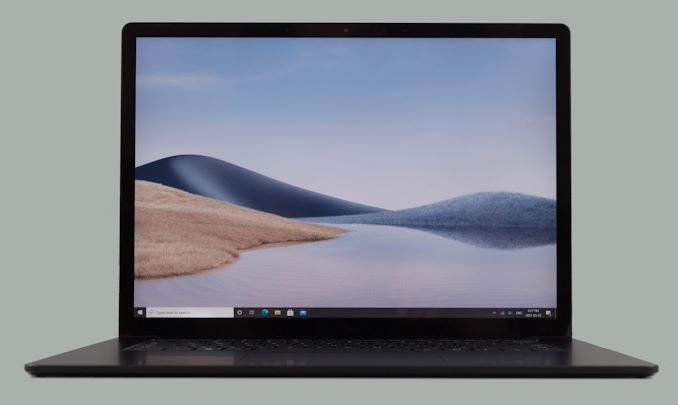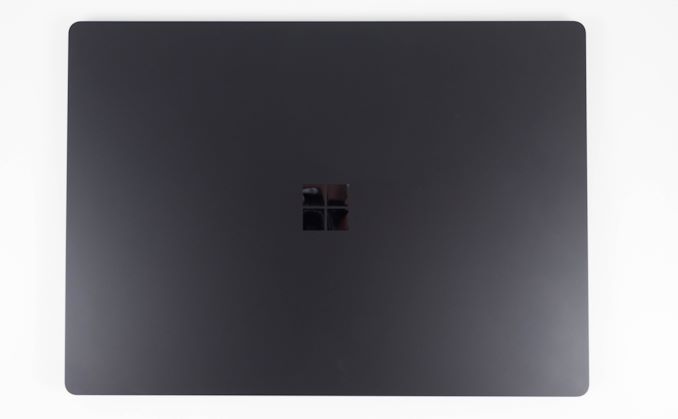The Microsoft Surface Laptop 4 15-Inch Review: Refreshing Ryzen
by Brett Howse on May 6, 2021 8:00 AM ESTFinal Words
In late 2019, when Microsoft launched the Surface Laptop 3 – their first AMD-powered Surface laptop – it was an important moment for both AMD and Microsoft's Surface group. AMD finally had a premium design win, and what better manufacturer did they have to work with than Microsoft themselves. Tweaks to improve performance and battery life could be easily replicated across all Windows PCs, which was a big help for AMD at the time. At the end of the day Microsoft's help still wasn't enough to make the AMD Ryzen 3000-based Surface Laptop 3 a bona fide winner – it performed worse than the Intel Ice Lake model and suffered from poor battery life – but it put AMD and Microsoft on the path towards building bigger and better laptops later on.
And now with the Surface Laptop 4 and the Ryzen 4000 APUs, Microsoft and AMD have resolved many (if not most) of the issues that dogged their earlier laptop. In fact, the Surface Laptop 4 is easily the best Ryzen 4000 laptop on the market. Microsoft has worked with AMD to deliver unique processors for the Surface Laptop 4 which are the strongest Renoir-U chips you can get. The increased frequency, coupled with eight cores and sixteen threads, makes for a very capable notebook computer.
And, unlike the Picasso-powered Surface Laptop 3, the AMD choice not only closes the gap in terms of battery life, according to Microsoft, the AMD model even surpasses the Tiger Lake model. Although we have not tested the Tiger Lake Surface Laptop 4 (yet?), the results from this Ryzen 7 model are excellent. Even with the 15-inch, 201 pixels-per-inch display, the Surface Laptop 4 was able to go toe-to-toe with some of the best designs on the market which have smaller displays. That is impressive.
Speaking of impressive, Microsoft’s attention to detail on the display really sets all Surface devices apart from the rest of the manufacturers. With any Surface device you purchase, from the least expensive, to the most expensive, the display accuracy is some of the best in the industry. The 3:2 aspect ratio is always a treat to use in any productivity task. The 201 pixels-per-inch makes the display sharp, and while a bit more contrast ratio would be appreciated, overall, this is an excellent implementation. It even includes a pen digitizer and touch support.
System performance with the Ryzen 7 4980U was excellent. Offering up sixteen threads, the Surface Laptop 4 gobbled up any multi-threaded task thrown at it. The Vega 8 graphics, while not class-leading, are still very strong for an integrated solution. Perhaps one area where the AMD model is let down though is that Microsoft only lets you configure it up to 16 GB of memory, whereas the Tiger Lake powered model has up to 32 GB as a maximum. This is an odd decision and will hopefully be addressed during the device’s lifetime.
Less impressive were the storage results on this review unit, which were some of the lowest we've seen for an NVMe drive in an OEM laptop. But the good news is that Microsoft has committed to utilizing M.2 storage on Surface again, after a brief stint of employed soldered in BGA storage. Customers will be able to replace the drive if it fails, or upgrade it. After years of making some of the most challenging to repair devices, Microsoft has turned a corner somewhat on repairability, with a new design that is easier to get into, and actually has some replaceable components.
With two sizes, a choice of colors, and even keyboard materials, there is a lot to like here. Microsoft offers a single USB Type-A, as well as a single USB Type-C, and additional expansion options through the Surface Connect port. This is not a workstation by any means, but it is nice to have both ports and not need to use dongles for Type-A devices.
Otherwise, although there was a bit of disappointment to see the Surface Laptop announced with the Ryzen 4000 series processors in 2021 instead of AMD's latest 5000 series processors, I believe those feelings can be set aside. There is little doubt that a Ryzen 5000 version of this laptop would be even more powerful with its Zen 3 cores, but Microsoft’s semi-custom Ryzen 7 4980U still performs very well, and should put any of those thoughts to bed. The Surface Laptop design is also mostly unchanged for the last several generations, and it could use a refresh, but that being said, the design was never really a hindrance before, and it is still pleasing to use today.
It is amazing what a generational improvement can do. The Surface Laptop 4 achieves great performance, and great battery life, and does so all in a pleasing package, with a great display, fantastic keyboard, smooth trackpad, and a thin and light design. On the outside, it would be hard to tell it apart from the Surface Laptop 3, but it’s what’s on the inside that counts. This refreshed model is just what the Surface Laptop needed.













98 Comments
View All Comments
richardshannon77 - Monday, May 10, 2021 - link
I've been working at home for the past year using a grand total of 0 type-A ports on my laptop. I have a type-C connection to a type-C dock and a type-A BT dongle attached to that for my mouse. I suspect that this is along the lines of what the gods of technological advancement had in mind. At this point, it's type-C for the win. Although, I can't figure out where to put my 3.5" floppies :/saratoga4 - Thursday, May 6, 2021 - link
Perfectly fine to have 1 USB-C port, but since its used for charging there should be at least two other ports. Doesn't matter what they are, just give me the ability to have a thumb drive and mouse while charging.This is something the (much smaller) Dell XPS 13 devices do a lot better. My older model has charging, 2x USB and TB. They apparently had so much space left over they even threw in an SD card slot. A 15" laptop shouldn't have so much less.
s.yu - Sunday, May 9, 2021 - link
For a second I thought that was an iPP there. Turns out there's 1A, 1C and the headphone jack, that's bad but not unusable.Kevin G - Thursday, May 6, 2021 - link
I think you're looking at it backwards as computer manufacturers have learned one thing: consumers will continue to buy products they don't like if there are no alternatives at the prices they want. Consumers have given up fighting as pricing has become the dominant factor and people don't want to spend more, especially in a market whose pricing has been slowly creeping up of late.The reduction of the number of ports historically has made sense for the most part: USB has won out. However with Type-C that can also carry power, things do get more complicated as you can lose a data port for a peripheral when you need to charge the unit. Devices that only have two USB ports feel anemic in this regard as users do notice when they'll have to pull double duty in a crunch.
Alistair - Thursday, May 6, 2021 - link
Some of what you said makes sense. But removeable batteries and storage are next level, not USB port level priorities. Come On. Apple charges $800 for 1TB storage that I can buy for $100 to add to the Surface. Bam, I'm interested in the Surface. Because my phone lacks a removeable battery, I generally upgrade every 24 months as the phone won't last. Removeable batteries enable 3 and 4 year ownership. These are not "USB port" level myopia.Kamen Rider Blade - Friday, May 7, 2021 - link
The point is that Renoir offers more ports internally on it's SoC.1x USB 3.2 Gen1 Type-C
5x USB 3.2 Gen1 Type-A
2x USB 2.0 Type-A
That's what is natively available, why not implement all of those USB ports?
MS doesn't want to maximize the features or ports on Renoir, that's their choice.
But to the end user, it's cheapening out on features that are available on the SoC and not used.
grant3 - Tuesday, May 11, 2021 - link
Your guarantee is now broken: I would buy a surface laptop if they included a single additional thunderbolt port.You're probably right that -many- people do not care about ports, but that is changing quickly as people set up their work-from-home hardware and start to realize how damn vital having a hub to connect their monitors and other peripherals is.
Apple, Dell, and other makers got the memo years ago. They give their premium 15" laptops at least 3+ ports. Microsoft apparently thinks it can replicate Apple's "Remove features and raise the price" approach to hardware success, but haven't clued into the fact that it only works when they simultaneously offer -some- compelling alternative to the hardware they removed.
Eletriarnation - Thursday, May 6, 2021 - link
They could have rearranged the layout and added to the BoM cost to get in a second Type-A port which probably >95% of the user base won't ever need. Or, they could tell that <5% to buy a hub and deal with it.drothgery - Thursday, May 6, 2021 - link
Lots of people use external devices; I've got a TB3/USB-C dock that I connect my home or work laptop to that's chained to a monitor, keyboard, mouse, power, and wired internet.Pretty much no one uses optical media on laptops (or desktops, to be honest), which is why you have to use an external drive for it even on big clunky gaming laptops.
Calin - Friday, May 7, 2021 - link
The volume and weight of an optical disk for laptops compares to a 48Wh battery.You could easily fit one more 2.5 inch SATA SSD _and_ another 20Wh of battery inside that, or SSD plus one M2 plus on SODIMM, and so on.
Even if 17" gaming laptops are huge, their internal space is at a premium due to the cooling necessary for the CPU and GPU. In this case, the volume and weight of the optical drives give you another 20% cooling capacity.
One of my university colleagues had a computer (in a tower case) with a CD drive (650 MB) and a 420MB hard drive. Even if that would have been a laptop, losing so much volume to removable media larger than the hard drive would have been a win.
Not so much for the present - 9GB double side double density DVDs or 50GB BluRays do not compare well to even 256GB SSD of the low end devices.